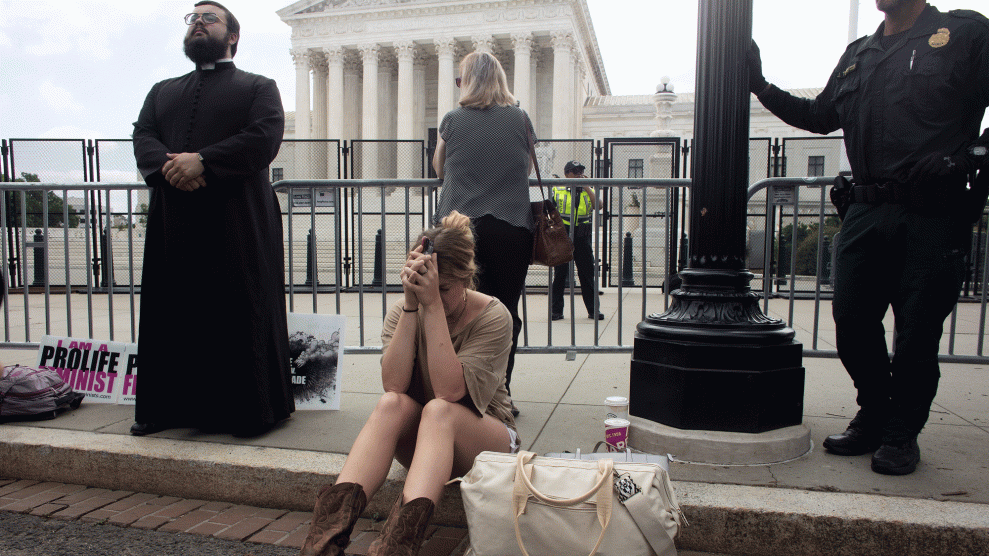
Andrew Lichtenstein/Getty
Emboldened by the Supreme Court’s decision demolishing the constitutional right to an abortion, Republicans have signaled that they plan to take further action to limit, if not eradicate, abortion rights by imposing federal restrictions. You don’t need a crystal ball to glimpse their game plan if they gain control of Congress and the White House. You simply have to look at the legislation GOP lawmakers have introduced over the past few years. Together, these bills would amount to a near-total abortion ban.
Below is a non-exhaustive list.
- Rep. Mike Kelly’s (R-Pa.) Heartbeat Protection Act would create a federal ban on abortions after a heartbeat is detected.
- Rep. Jody Hice’s (R-Ga.) Sanctity of Human Life bill would “declare” human life as beginning when sperm fertilizes an egg, and that as such, those fertilized eggs would have constitutional rights.
- Rep. Alexander Mooney (R-WV) Life at Conception Act would provide 14th Amendment protections—namely, the right to life—to any fertilized egg.
- Rep. Mike Johnson’s (R-La.)’s Child Interstate Abortion Notification Act would make it a federal crime to transport a minor across state lines for an abortion without parental consent.
- Rep. Debbie Lasko’s (R-Ariz.) Dismemberment Abortion Ban Act would prohibit most second-trimester abortions across the country.
These bills have widespread Republican support. Each has at least a dozen cosponsors. Mooney’s bill has more than 160. A conservative House Republican caucus—the Republican Study Committee, of which roughly 75 percent of House Republican are members—also supports this entire slate of legislation.
In the wake of the Dobbs v. Jackson Women’s Health Organization decision, top Republicans have made no secret of their desire to press for national abortion laws. House Minority Leader Kevin McCarthy told CNN he’d support a nationwide abortion ban for pregnancies beyond 15 weeks of gestation, for example, while former Vice President Mike Pence tweeted that the GOP “must not rest and must not relent until the sanctity of life is restored to the center of American law in every state in the land.” (Democrats also tried to pass their own national abortion law, the Women’s Health Protection Act, which sought to codify Roe v. Wade before the Dobbs decision was released. It failed in the Senate. On Thursday, President Joe Biden also called for a filibuster carveout to advance national abortion protections via a simple Senate majority.)
These Republican-authored bills stand no chance of passing in the current Congress, with both chambers narrowly controlled by Democrats. Nor is it likely that any of these bills would be signed into law by Democratic President Joe Biden, even if Republicans were to win big in the November midterm elections and take back control of both congressional chambers. But these anti-abortion bills do indicate GOP intentions. Essentially, they form a roadmap showing how the party may try to govern the next time they have the power—in both the White House and in Congress—to do so.
The bills “tell us where they are going,” says Priscilla Smith, the director of Yale Law School’s Program for the Study of Reproductive Justice.
What a Republican-controlled Congress would attempt legislatively is pretty clear; whether these measures are constitutional is another matter.
Through Article 1, Section 8 of the Constitution, Congress has the power to regulate interstate commerce: essentially, it can intervene in state matters that have substantial effect on the national economy. In the early 1900s, Congress used this power to pass the Mann Act, which made it a criminal felony to transport women across state lines for immoral purposes. Back then, the bill’s reliance on the Commerce Clause was an attempt at reducing prostitution and human trafficking. A similar interpretation today could be used to support Rep. Johnson’s Child Interstate Abortion Notification Act, says Stephen Gilles, an originalist law professor at Quinnipiac University. “That’s not a total pipe dream,” he says.
Most of the other anti-abortion bills have less straightforward judicial precedent.
Rep. Hice’s bill declaring life begins at fertilization is among the ones that may be outside Congress’ scope of authority. “Congress has the power to raise money, to impose taxes, to regulate commerce, and to do all kinds of things. But to define when life begins—nothing in the Constitution gives Congress the power to do that,” says Sylvia Law, a reproductive health law scholar at New York University School of Law.
Nor does Hice’s bill make much sense, scientifically. A fertilized egg is not a fetus. It’s just cells. “Plenty of fertilized eggs never result in a pregnancy. They either fertilize too late and they miss the opportunity to implant, or they are dividing inappropriately and don’t have the right signal to implant,” says Villavicencio. “So the idea that that is life in and of itself doesn’t really make sense with the biology.”
That doesn’t mean Republicans wouldn’t try to push through their bills. The Constitution gives Congress the authority to enforce the 14th Amendment, which forbids states from depriving “any person of life, liberty, or property, without due process of law.” Republicans could therefore argue that Congress has the power to enforce 14th Amendment protections on behalf of fertilized eggs and fetuses. The Supreme Court, though, has also ruled that Section Five of the14th Amendment does not grant Congress the power to create new rights or expand existing rights.
Theoretically, Congress could also argue the Commerce Clause gives the legislative branch broad authority to enforce abortion laws—either codifying the right to an abortion, or enacting a nationwide ban—if the justification for either law was based on how such a law would impact the national economy.
If any of these bills were passed by a Republican-led Congress and then signed into law by a Republican president, it would likely bring us right back where we started: the federal judicial system that just overturned the constitutional right to an abortion. And there are some hints at how at least one Republican justice who overturned Roe might rule.
The majority Dobbs opinion repeatedly suggests the right to an abortion should be left to elected state representatives to decide, but Supreme Court Justice Brett Kavanaugh’s concurring opinion seems to invite Congress to pick a side.
“On the question of abortion, the Constitution is therefore neither pro-life nor pro-choice. The Constitution is neutral and leaves the issue for the people and their elected representatives to resolve through the democratic process in the States or Congress,” Kavanaugh writes.
Concurring Supreme Court opinions have no legal authority on their own. They are relevant, however, in predicting how a Justice might side if another relevant case comes before the court.
Kavanaugh’s concurring opinion was “written to suggest that he at least believes that Congress may have that power,” says Gilles. “If he believes that, then I’m almost sure he believes that Congress could either prohibit abortions or require states to permit them.”
And while no fellow Justices joined Kavanaugh’s concurring opinion, he likely isn’t alone in his judicial interpretation, given the disproportionately high number of conservative judges Former President Donald Trump was able to appoint in just one term. (Trump appointed 54 federal appellate judges in four years, almost the exact same number former President Barack Obama appointed in eight years, according to Pew Research Center. Trump also nominated the highest number of eventual Supreme Court Justices of any one-term President since Herbert Hoover.)
Smith believes that, post-Dobbs, the current federal court system could indeed permit Congress to legislate abortion, despite the shaky constitutional grounds.”It’s been a huge uphill battle with the current courts—both lower courts that are filled with radical conservatives and with the current Supreme Court,” she says. “Until the composition of the Supreme Court changes,” she says, “we’re out of luck.”
















